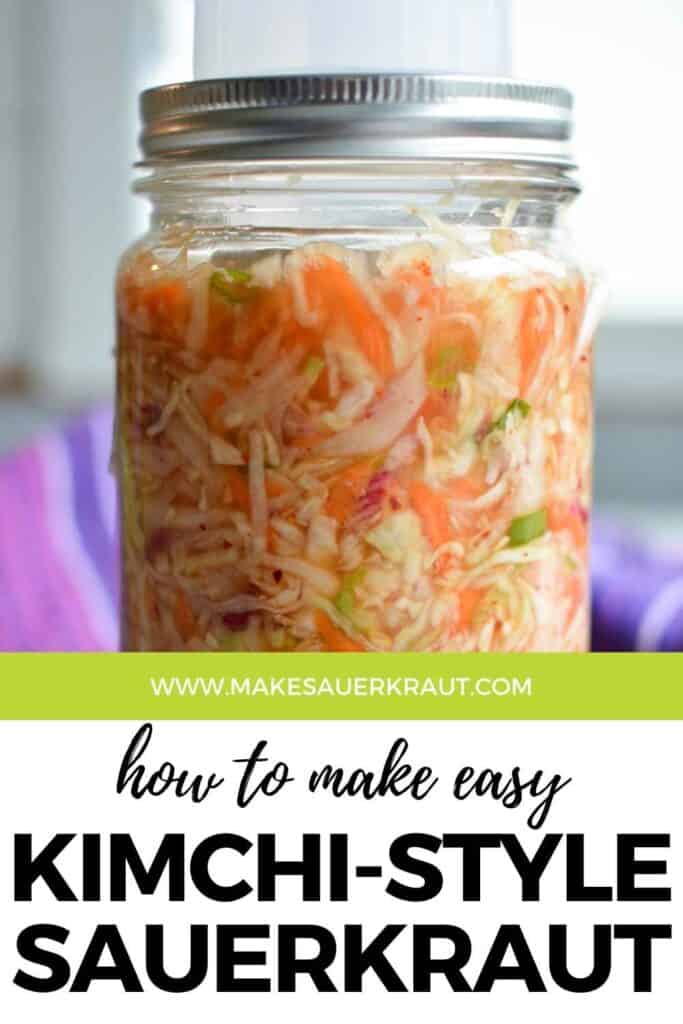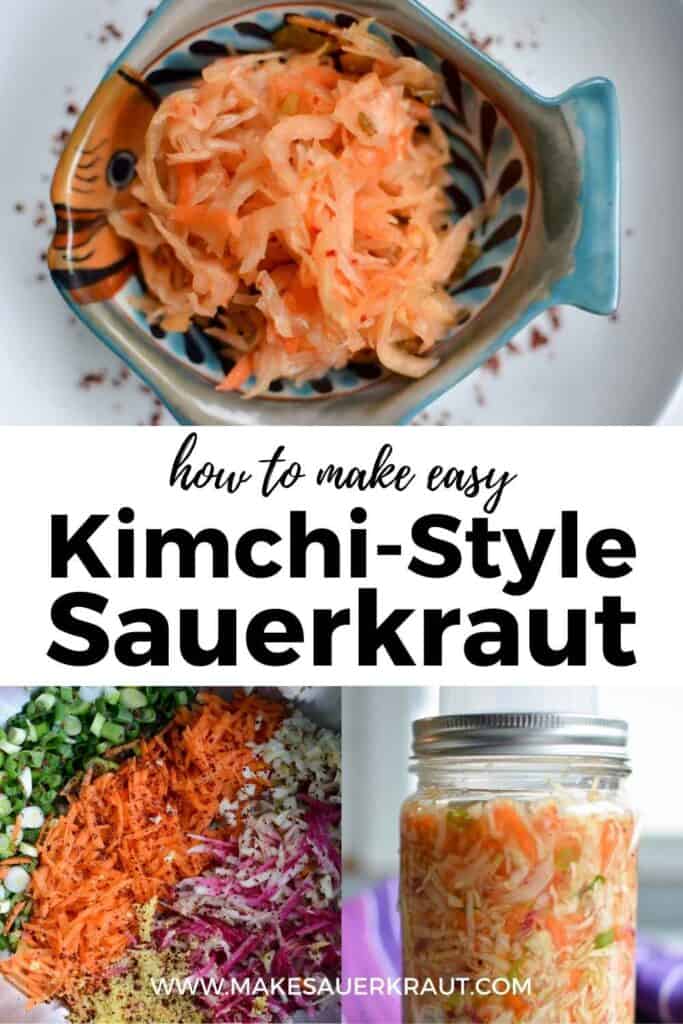Discover the simplicity of making kimchi sauerkraut with our recipe that bypasses traditional complexities like soaking cabbage and crafting kimchi paste. Perfect for those with a busy schedule or anyone keen to dive into homemade fermented delights, this recipe promises traditional kimchi flavors in a fraction of the time.
One reader, Megan, commented: “I made this as an emergency birthday present for my husband during our New Zealand lockdown. He opened and tasted it last weekend and said we never need to buy kimchi again. He tolerates other sauerkrauts, but this one he loves. I’m calling that a success!!! Thanks, Holly, for the recipe, an easy first step into kimchi-making.“ ★★★★★
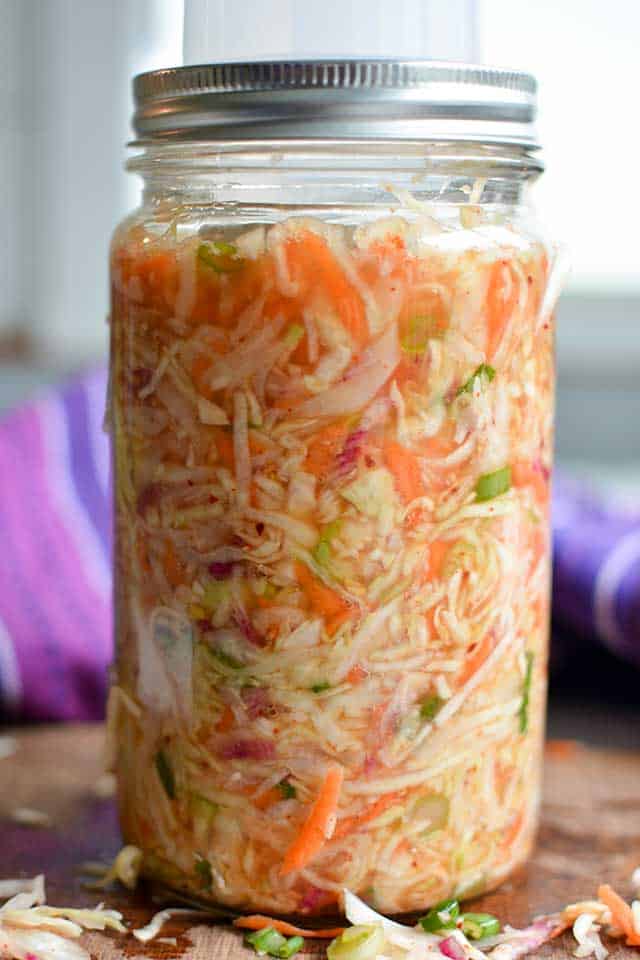
Years ago, a friend who served in the Peace Corps in Korea talked of one of his most difficult cultural experiences: learning to eat kimchi, the cornerstone of the Korean diet, which is served morning, noon, and night. He couldn’t stomach its strong smell and intense taste.
Fast forward forty years, and I’m now making kimchi, loving it, and wondering what my friend was complaining about.
Well, while researching how to make traditional kimchi, I discovered why. I stumbled across a missing ingredient in my original Americanized kimchi sauerkraut recipe: fermented fish sauce!
Some styles of kimchi also include fermented fish. I don’t think I’m ready for that.
But once I understood the flavor value of fermented fish sauce, I tried it and was pleasantly surprised. There were no overpowering flavors or smells but a nuanced depth that is hard to do without. My updated recipe includes it as an optional ingredient.
In Korea, kimchi is more than just food; it’s an integral part of the culture, with the average Korean consuming approximately 40 pounds annually. That is one jar a week compared to our one jar a year.
Kimchi-making is a communal activity, highlighted by events like the annual Kimchi Making Festival in Seoul, where over 2,000 volunteers prepare 270 tonnes of kimchi for those in need during winter.

This deep cultural engagement with fermentation, which forms a core part of daily life and community support, attracted me to this regional dish.
Don’t worry, making Kimchi-Style Sauerkraut couldn’t be easier and you too might want to include fermented fish sauce in your version.
Here’s Why You’ll Love Kimchi-Style Sauerkraut
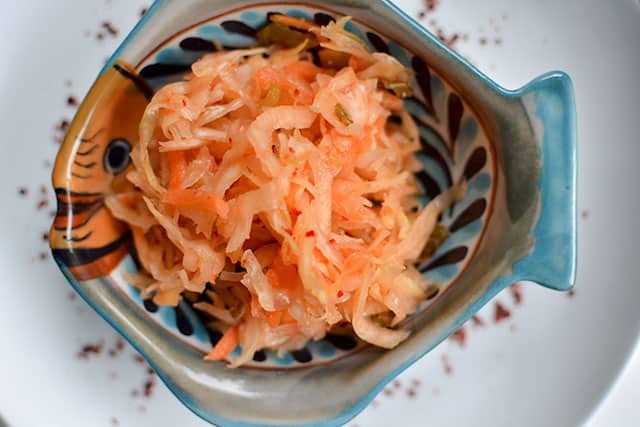
In this recipe, we make Kimchi-Style Sauerkraut which has the flavors of kimchi without the extra preparation. For more on the difference between traditional kimchi and sauerkraut, read here.
Flavor: This Kimchi-Style Sauerkraut offers a rich and complex taste profile, blending the tanginess of traditional sauerkraut with the spicy and umami flavors characteristic of kimchi. This blend creates a unique and delicious flavor experience.
Texture: The texture is crisp and refreshing, with a satisfying crunch from the combination of green cabbage, carrots, and radishes. This contrasts pleasantly with the softer textures typically found in traditional kimchi.
Ease: This Kimchi-Style Sauerkraut is simpler to make than traditional kimchi. It eliminates the need to soak the cabbage or prepare a complex kimchi paste while still delivering the unique flavors of kimchi.
Time: Unlike traditional kimchi, which can be time-consuming to prepare, this Kimchi-Style Sauerkraut can be ready for fermentation in less than an hour. This quick prep time is ideal for busy individuals or those eager to enjoy homemade fermented foods without the lengthy preparation process typically associated with kimchi.
Grab your bowl, and let’s get started.
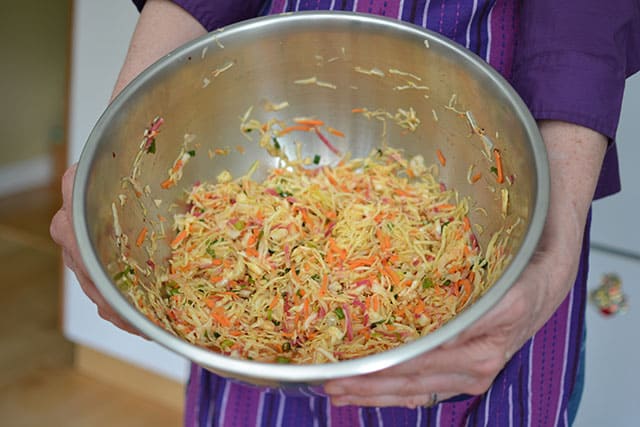
This post was originally published on September 26, 2014. It was last updated in Jan of 2024.
To learn my step-by-step process for making any sauerkraut, check out my Ultimate Beginner’s Guide.

Key Kimchi Ingredients
Vegetables in Traditional Kimchi
Grated carrots, radish, green onion, ginger, and garlic are traditional ingredients in kimchi, and they are included in this recipe.
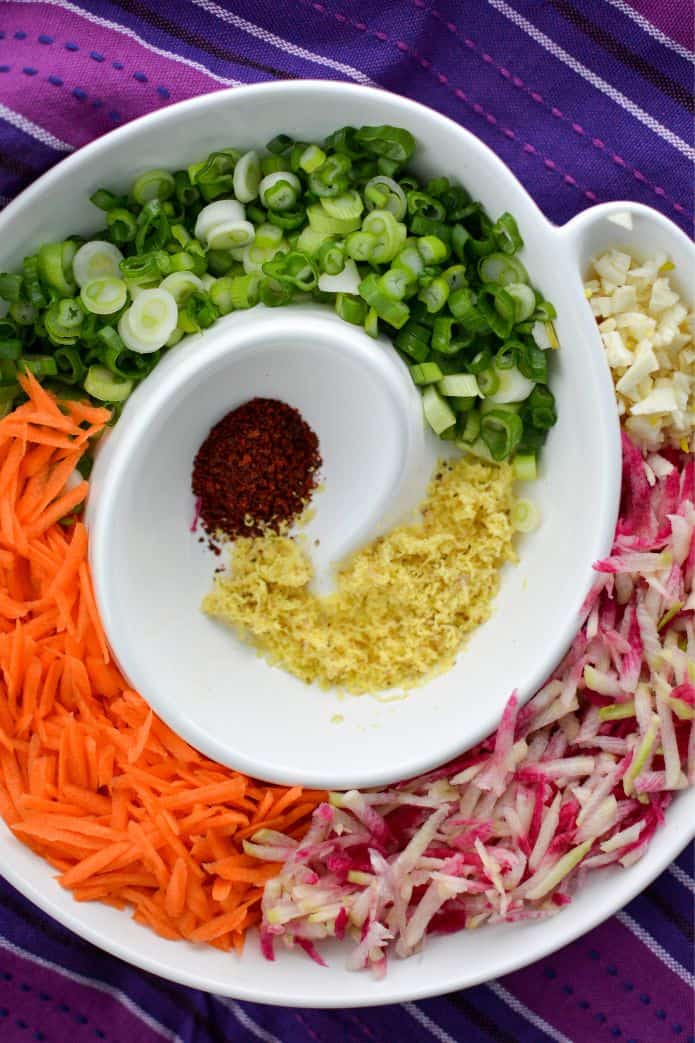
Green Cabbage
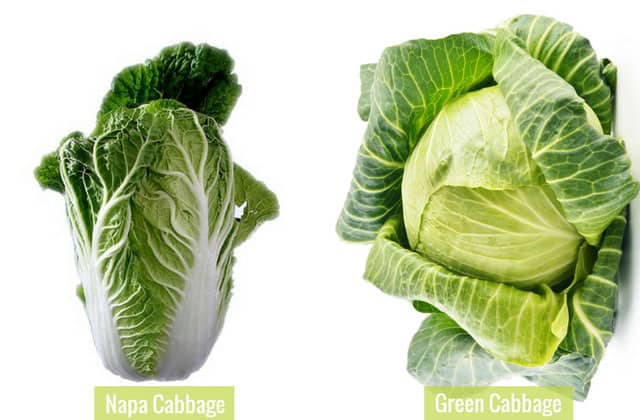
This recipe simplifies the kimchi experience using regular green cabbage, ensuring a consistently nice texture.
Traditional kimchi typically uses Napa cabbage soaked in salty brine and mixed with a spicy paste. I don’t recommend using Napa cabbage in this sauerkraut recipe. Doing so can lead to a mixed texture in the final product due to Napa cabbage’s thick stalks and fine leaves.
Gochugaru
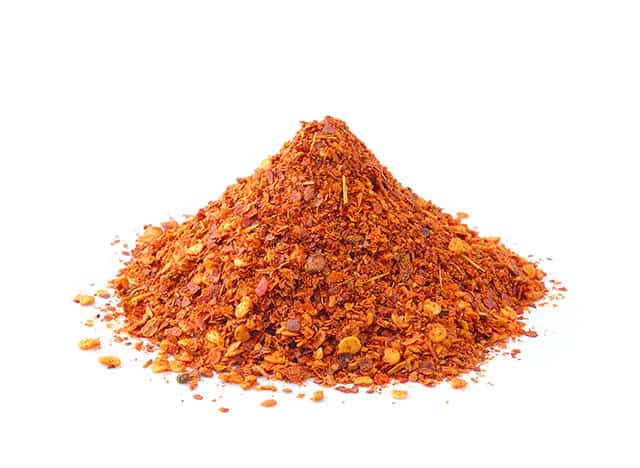
Gochugaru—Korean red pepper flakes—is traditionally used to flavor and add heat to Kimchi.
It is a coarsely ground red pepper with a texture between flakes and powder that disperses throughout your sauerkraut, coloring it beautifully and adding a complex flavor not found with red pepper flakes.
Tips for buying, using, and storing (with more details on my in-depth gochugaru post):
- The highest quality gochugaru is made from sun-dried chili peppers.
- Look for flakes, not powder. The powder is used in Gochujang, a traditional sauce used on dishes as we would use ketchup.
- Look for sun-dried and without seeds.
- When searching the internet, search for “gochugaru flakes”
- Store your gochugaru red pepper powder in your freezer to extend its shelf life.
- If gochugaru is not available, substitute red pepper flakes.
- Don’t hesitate to buy a one-pound bag. It is used in large quantities and stores well.
Some brands to look for are “Mother-in-Law’s,” “Crazy Korean Cooking,” and “Tae Kyung.” Here are some Amazon options. If out of stock, use the buying tips above.
- SWEET HEAT: Our Korean Chile Flakes are made from premium peppers, offering a fruity spiciness…
- NO SEEDS: As a symbol of quality, Mother-in-Law’s gochugaru flakes contain almost no seeds,…
- FLAVOR NOTES: The unique balance of earthiness, spiciness and complexity, along with medium…
- RED CHILI PEPPER FOR KIMCHI – Coarse gochugaru flakes used for making kimchi and cooking Korean…
- AUTHENTIC KOREAN SPICE SEASONING – Regular spicy flavor with Scoville Heat Unit of around…
- 100% PEPPER ONLY – A kosher seasoning with no added MSG or additives. Korean government poses…
Fish Sauce
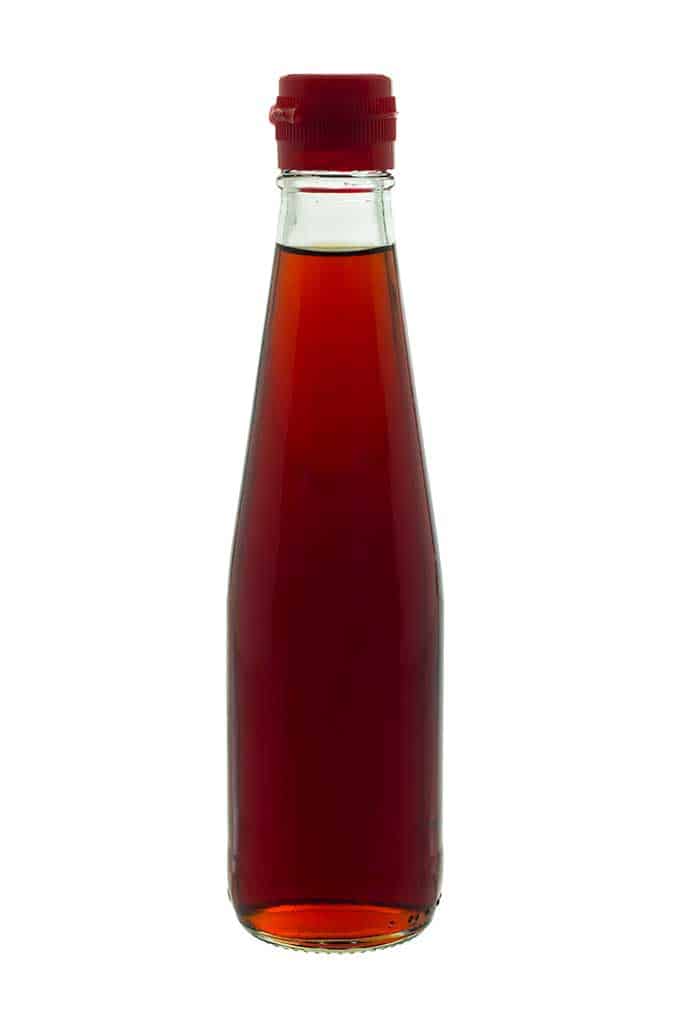
Fish sauce is a liquid condiment prepared from fermented anchovies and salt. It is a staple seasoning in the cuisines of Southeast and East Asia and is a key ingredient in many styles of kimchi. For many, however, just the thought of fish sauce can be rather off-putting.
Don’t make the mistake – as I did – of waiting years to incorporate this flavor-unleashing ingredient into your kitchen. Once you taste the incredible flavors of fish sauce, you will be dousing every dish in your kitchen with it. Learn to use it properly, and it becomes a robust flavor booster, with no trace of fishiness remaining.
The secret behind this powerful ingredient?
Umami! and further explained in my article on fish sauce.
Had to chuckle at your reference that the fish sauce in kimchi is why it was nasty. Fish sauce is a flavor that smells nasty but, in moderation, gives a dish an amazing umami flavor that you can’t pinpoint.
But kimchi is also made traditionally with raw oysters fermented in or fermented squid. I admit I have not had the guts to try this yet. I think that the kimchi your friend had may have included raw oysters or have been heavily fermented.
Kimchi scared me for years. I only had nibbles occasionally, and it was an odd taste. I don’t consider my palate all that adventurous and I find lightly fermented kimchi amazing. When it gets more heavily fermented I make stew or pancakes out of it.
—Kristin
In Pictures: How to Make Kimchi
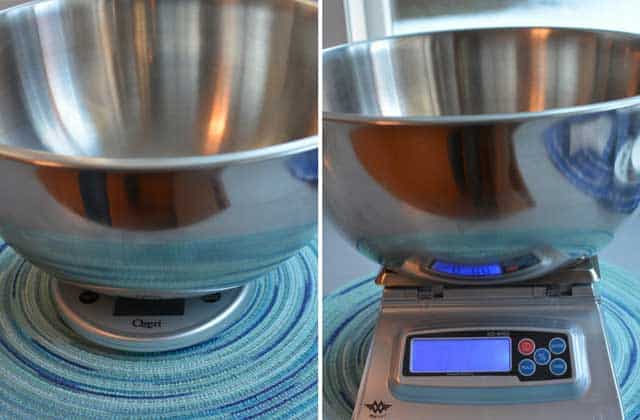
You don’t want to include the weight of your bowl in your measurements, so either zero out the scale (press the TARE button) or write down the weight of your bowl.
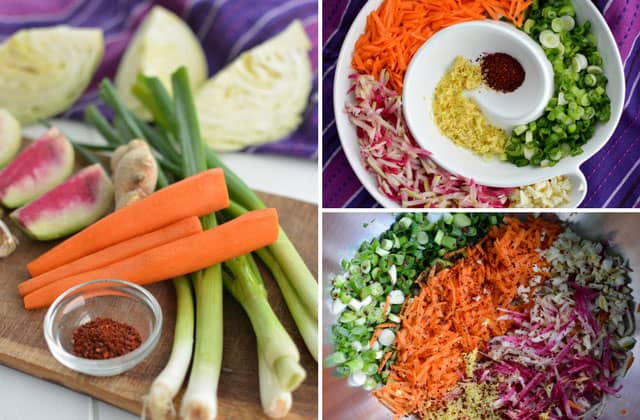
Mince garlic and ginger, shred carrots and radish, slice green onions, and add to your bowl along with the gochugaru and fish sauce.
Add sliced cabbage to your bowl until the weight of your vegetables and cabbage is 1¾ pounds (28 ounces, 800 grams).
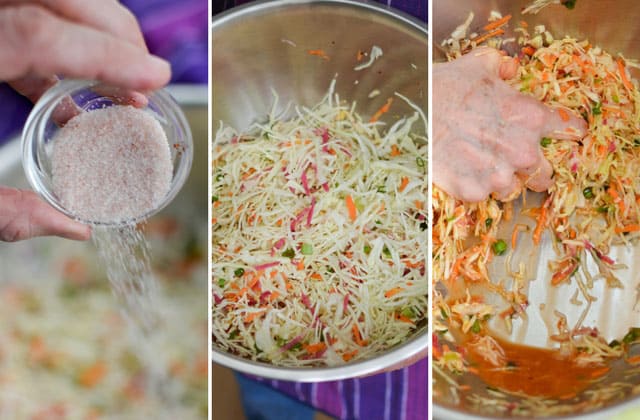
Sprinkle vegetables and cabbage with 1 tablespoon of salt and mix well. Then, massage the vegetables with strong hands until moist, creating the brine.
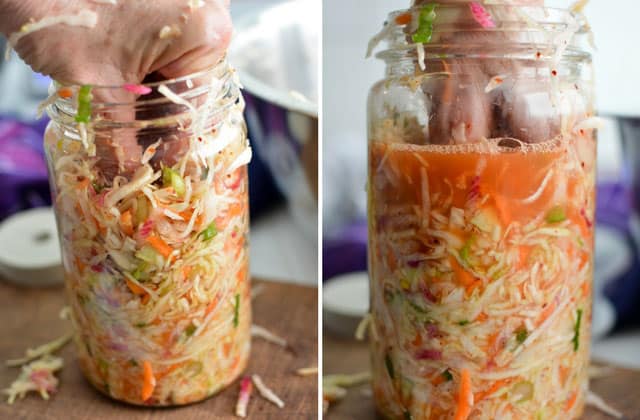
Grab handfuls of the salty, juicy cabbage mixture and pack them into your jar, periodically pressing the mixture down tightly with your fist.
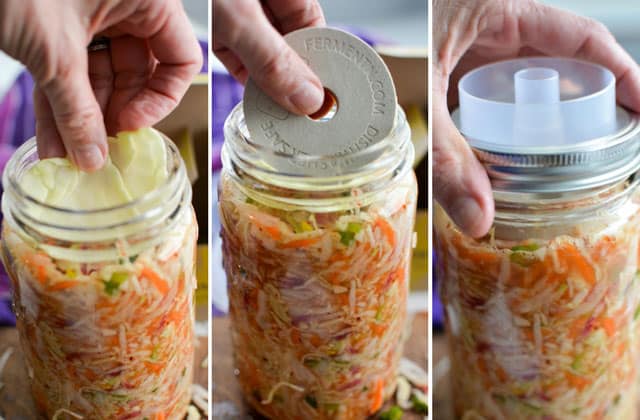
Place a 4-ounce jelly jar (or preferred weight) on top of the cabbage leaf, right side up with its lid removed. (Here I’m using the weight included with the Ferment’n fermentation lid.)
Lightly (to allow for gases to escape), screw on the white plastic storage lid or airlock of your choice, following their directions.
Recipe Notes and Tips
Two Easy Ways to Peel Ginger
I keep both fresh and frozen ginger on hand. For frozen ginger, grate it using the fine side of your grater. The peel is left on the outside of the grater box, and the minced ginger sits in a nice pile on your cutting board, ready to be scraped into your sauerkraut mixing bowl.
I used to peel fresh ginger with my vegetable peeler and often bemoaned at how much ginger I was losing. Try the Spoon Trick instead, as shown in the video below.
Turn Up – or Down – the Heat
The spiciness or heat of Gochugaru or red pepper flakes can vary greatly. If you like it hot, use 1 teaspoon of red pepper flakes. If you don’t want it too spicy, use 1/2 teaspoon instead. Then, adjust for future batches or taste after mixing in the salt, and add more red pepper if you feel it needs it.
Don’t Want to Irritate Your Hands with the Red Pepper?
If your hands are sensitive to the capsicum in the red pepper, don’t add them to your bowl until you have mixed all your cabbage and vegetables together and created your brine. Then, sprinkle on the red pepper flakes, quickly mix, and pack into your jar. You also might want to consider wearing a pair of thin plastic gloves when making this sauerkraut or using a large spoon when mixing and packing.
Ways to Eat Kimchi-Style Sauerkraut
I maintain an ever-growing list of ways to enjoy your sauerkraut. Check out #20: Peanut Butter Kimchi Sandwich!
Kimchi-Style Sauerkraut Recipe
I have two forms of my Kimchi-Style Sauerkraut Recipe for you. The online one that follows – with numerous pictures – and a PDF version below for printing that includes Gourmet Pairing Options and information on recipe ingredients.
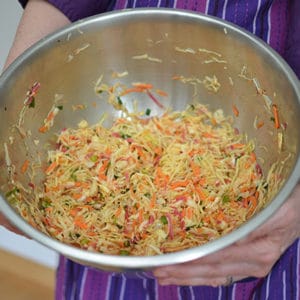
Kimchi Style Sauerkraut
EQUIPMENT
- Digital scale
- Cutting board and chef’s knife
- Large mixing bowl
- Vegetable peeler and grater
- 1-quart (L) wide-mouth canning jar or similar sized jar
- 4-ounce (125 ml) canning jar (jelly jar) or fermentation weight
- Wide-mouth plastic storage cap (or lid and rim that comes with jar)
INGREDIENTS
- 1 medium head fresh green cabbage, 2 ½–3 pounds (1 kg), 2 ½–3 pounds
- 1-2 carrots
- 1 bunch green onions
- 1 large radish (1/2 cup gradted), (watermelon radish is nice) or a bunch of small red radishs
- 1 inch knob fresh ginger
- 2-3 cloves garlic
- 1-2 teaspoon Korean red pepper powder (gochugaru)
- 1 tablespoon fish sauce, optional, but highly recommended
- 1 tablespoon iodine-free salt (fine-grain) (16 grams)
INSTRUCTIONS
- SET UP. Gather Supplies and Set Up ScaleUsing a digital scale to weigh your ingredients is THE secret for delicious sauerkraut… batch after batch.You don’t want to include the weight of your bowl in your measurements, so either zero out the scale (usually done with a TARE button) or write down weight of your bowl.
- CHOP. Prep Your Vegetables and CabbageWhen making sauerkraut, you first prepare the flavoring ingredients – carrots, ginger, radish, caraway seeds, or whatnot – then add sliced cabbage. This allows you to add only as much sliced cabbage as necessary to hit 800 grams (1¾ pounds, 28 ounces) on the scale, the amount that fits perfectly – usually – into a 1-quart (liter) jar. Grate carrots and radish, thinly slice green onions, grate ginger and mince garlic, placing everything, along with the red pepper flakes or Korean red pepper and optional fish sauce, in your bowl. NOTE: If you're concerned about the "hot" nature of the red pepper on your bare hands, either wear gloves or quickly mix it in right before packing your jar.Discard the dirty or limp outer leaves of your cabbage, setting aside one of the cleaner leaves for use during the SUBMERGE step.Quarter, then slice cabbage crosswise into thin ribbons. I leave the core in because I find it helps to hold the layers of cabbage together making the slicing job easier.Add sliced cabbage to your bowl until the weight of your vegetables and cabbage is 800 grams (1¾ pounds, 28 ounces).
- SALT. Create Your BrineSalt pulls water out of the cabbage and vegetables to create an environment where the good bacteria (mainly lactobacillus) can grow and proliferate and the bad bacteria die off.Sprinkle vegetables and cabbage with 1 tablespoon of salt (16 grams) and mix well. Then, massage the vegetables with strong hands until moist, creating the brine.You should be able to tilt the bowl to the side and see a good-sized puddle of brine, about 2–3 inches in diameter. This process can take anywhere from 2 to 5 minutes. Notice how the mixture has shrunk. Due to the hot nature of the red pepper, wash hands well after.
- PACK. Pack Mixture into JarGrab handfuls of the salty, juicy cabbage mixture and pack them into your quart-sized (liter) wide-mouth canning jar, periodically pressing the mixture down tightly with your fist or a large spoon so that the brine rises above the top of the mixture and no air pockets remain.Be sure to leave at least 1 inch of space between the top of the cabbage and the top of the jar. This should happen automatically because we weighed out just the right amount of cabbage to fit in your jar.Pour any brine left in your mixing bowl into the jar and scrape out any loose bits stuck to the sides of the bowl or jar.
- SUBMERGE. Hold Ferment Below BrineNow, make sure your fermenting mixture is in a safe anaerobic (no air) environment. This means keeping the cabbage mixture submerged in the brine while it ferments. Take that cabbage leaf you saved during the SETUP step, tear it down to fit in the jar, and place it on the surface of the packed cabbage. Forgot to save a cabbage leaf? No problem. You can fold a narrow piece of parchment paper to size or even cut an old plastic lid to size. Place the 4-ounce jelly jar (or preferred weight) on top of the cabbage leaf, right side up, with its lid removed.Lightly (to allow for the escape of CO2 gases), screw on the white plastic storage lid or airlock of your choice, following their directions.I like to label my jars using green or blue painter’s tape and a permanent marker. I note the flavor of sauerkraut I made and the date I started fermenting.For this recipe, I used the Ferment'n water-sealed fermentation lid. It comes with a weight, the water trough you hold in place with a metal canning band and the lid.
- FERMENT. Ferment for 1 to 4 WeeksTime now for the friendly bacteria to do their work while you watch and wait. Can you wait 7 days to taste the tangy crunch?Place your jar of fermenting sauerkraut in a shallow bowl (to catch the brine that may leak out during the first week of fermentation), out of direct sunlight. Wait for 1 week before opening to sample.For what to expect as your sauerkraut ferments, see SALTY Cabbage to SOUR Sauerkraut: Fermentation Signs to MonitorShould the brine level fall (very unlikely) and remain below the level of the sauerkraut during this first week, dilute 1 Tbsp of salt in 2 cups of water and pour some of this brine over the sauerkraut (removing the little jar first) until it just covers the mixture. Put the little jar back in, screw the lid on lightly and let the fermentation continue.Don’t worry if the brine disappears after the 7- to 10-day mark. By this time, you’ve created a safe environment in which the bacteria that would cause mold or slime has been chased away by the beneficial bacteria produced during the fermentation process.You can ferment your sauerkraut for up to 4 weeks. The longer you ferment it, the greater the number and variety of beneficial bacteria that can be produced.
- STORE. Store in Refrigerator for Up to 1 YearAfter fermenting your sauerkraut, it’s ready to go into the refrigerator and ready to be eaten. Rinse off the outside of the jar. You can take the little jar out. Clean the rim if necessary (sometimes it can get sticky from the brine that overflows), and screw the lid back on tightly. Add to your label how long you fermented the contents.Enjoy a forkful or two of your kimchi sauerkraut with your meals. It will continue to ferment – aging like a fine wine – but much slower than before. If the flavors are too intense, leave the jar in the fridge for a month or two and then eat it. You will be amazed at how the flavors have changed.If successfully fermented (tastes and smells good), your sauerkraut can be kept preserved in your refrigerator for up to a year.
Notes and Tips
- Adjusting the heat: The spiciness of Gochugaru or red pepper flakes can vary greatly. If you like it hot, use 1 teaspoon; for a milder version, use 1/2 teaspoon. Take notes and adjust for future batches.
- Protect hands: If your hands are sensitive to the capsicum in the red pepper, use a spoon when mixing and packing. You also might want to consider wearing a pair of thin plastic gloves.
- Fish Sauce: Optional, but highly recommended. My favorite is Red Boat. You can read more about fish sauce here. The fishy smell dissipates during fermentation. One of my readers successfully substituted soy sauce for the fish sauce.
- Special equipment (affiliate links): Digital scale, MyWeigh KD-8000 (my favorite), Etekcity Food Scale, salt, mixing bowl, wide-mouth jars, fermentation springs, storage lids
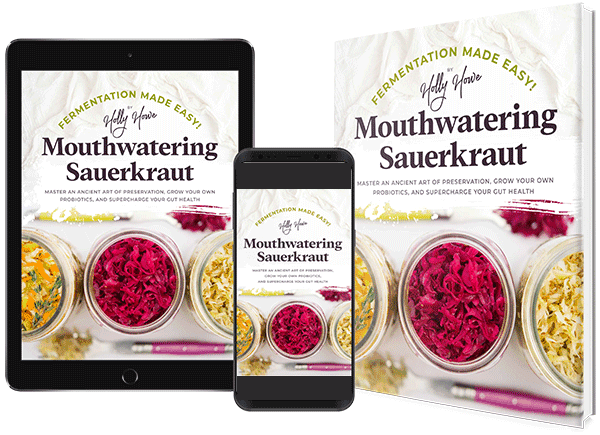
The Book That Will Transform Your Meals, And… Your Health
Learn to make gut-healing sauerkraut to instantly add delicious flavors to your meals. Step-by-step, easy-to-follow instructions with photos and tips.
Kimchi-Style Sauerkraut Recipe PDF
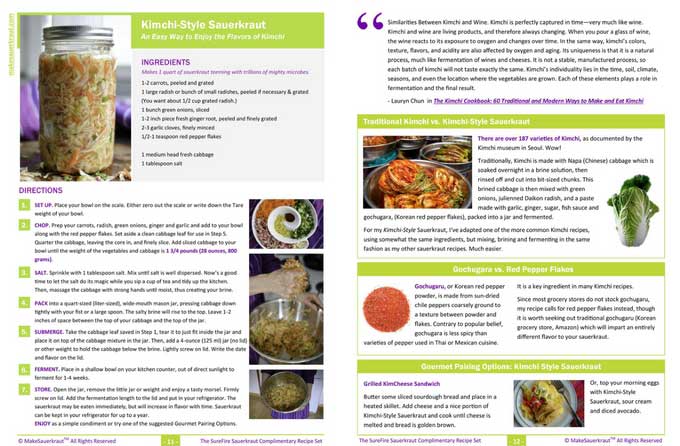
FREE PDF Download
Use the button below to get your PDF copy of the Kimchi-Style Sauerkraut recipe. No Opt-In is required.
Last update on 2024-04-19 / Affiliate links / Images from Amazon Product Advertising API

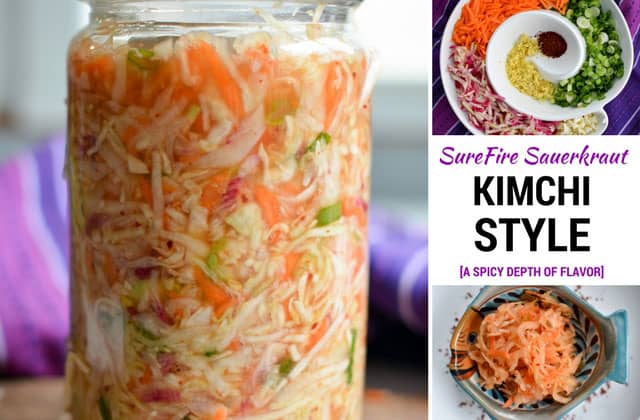

 This post may contain affiliate links which won’t change your price but will share some commission.
This post may contain affiliate links which won’t change your price but will share some commission.
